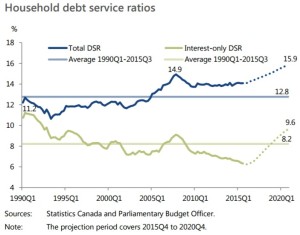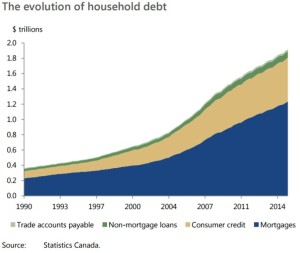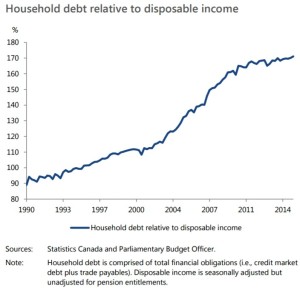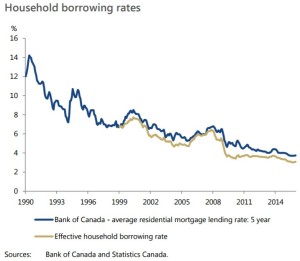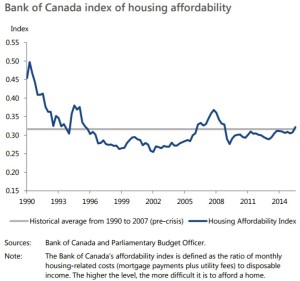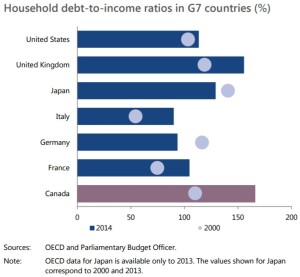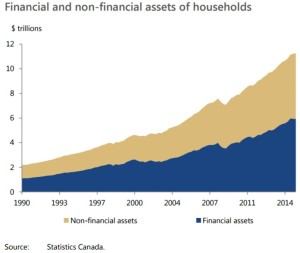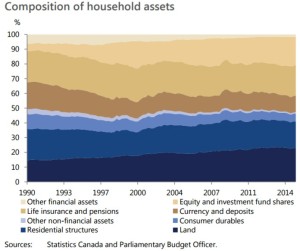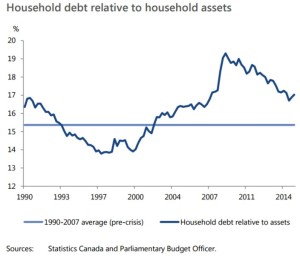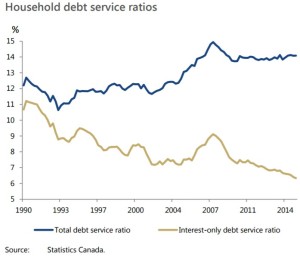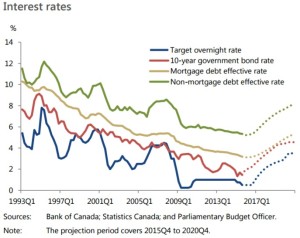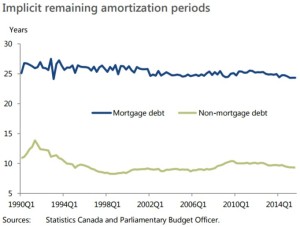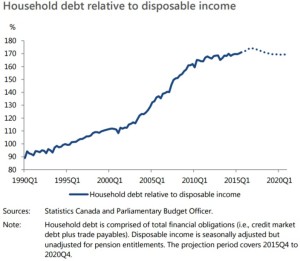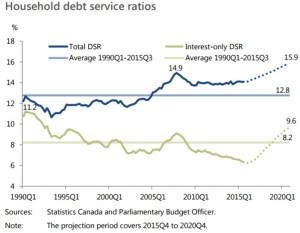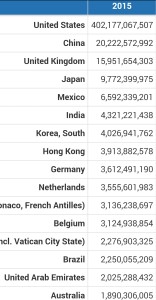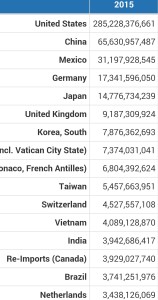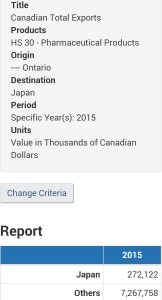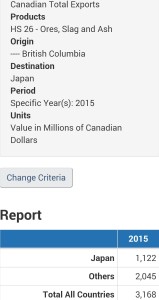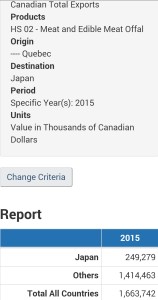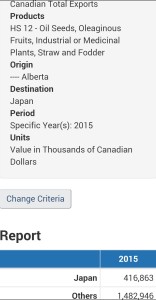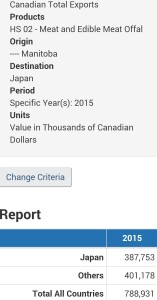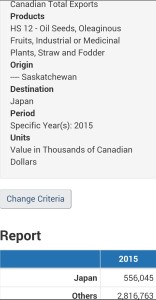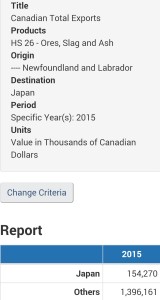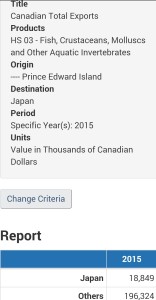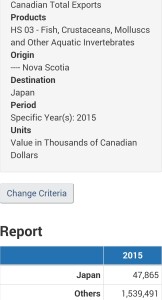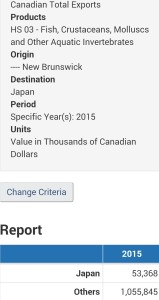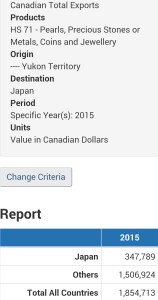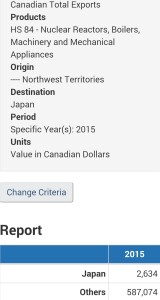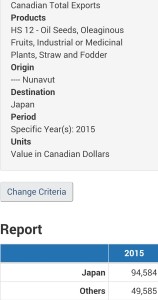今回は、カナダです。
tweet: CANADA
Coverage in @Cdn_Mining_Jrnl of ICMM's 4th Mining Contribution Index just out – which finds that between 2014 and 2016, many mineral dependent countries became even more dependent on #mining revenues https://t.co/Z0INZ5U5mc
— Mining Shared Value (@ewb_msv) October 7, 2018
ICYMI | A new exhibit at the Canada Science and Technology Museum uses puts awe-inspiring LEGO creations on display. https://t.co/n6bED3bLlS pic.twitter.com/gI58ZnI7mb
— CBC Ottawa (@CBCOttawa) May 15, 2018
https://twitter.com/Energy_Citizens/status/1039680995673419776
Without a new deal for host countries based on #automation and new #technology – #miners may automate themselves out of a welcome, says Jeff Geipel, Mining Shared Value initiative of Engineers Without Borders Canada: https://t.co/9GoSkpP5H6 @ewb_msv @jdgeipel #futureofmining pic.twitter.com/ihO4IrQZSZ
— Mining Magazine (@MiningMagazine) October 13, 2018
INFOGRAPHIC: How hydraulic fracturing works, and why it's a safe and proven technology that's been used in Canada for more than 60 years: https://t.co/OY57G7CLEN #natgas #fracking #Canada pic.twitter.com/B7H3AI2gvp
— CAPP Oil Gas Canada (@OilGasCanada) July 23, 2018
https://twitter.com/invest_canada/status/1004830792906952705
https://twitter.com/HydrogenCouncil/status/1032262866060156928
The #SmartCity model has a flaw at its core: #corporations are seeking to exert influence on #urbanspaces and #democraticgovernance. We must recognize #SmartCities as a #political issue, not a #technology issue. https://t.co/ee7O3p23MI @biancawylie #sidewalktoronto #Canada #data
— Julian Agyeman (@julianagyeman) August 21, 2018
Canada has serious tech allure, and for good reason: https://t.co/atbgswgXaB // Technologies au Canada : le Canada attire les meilleurs talents pour les bonnes raisons
cc @MaRSDD @SamsungCanada #cdntech #InvestInCanada #investiraucanada
— Jim Carr (@jimcarr_wpg) July 31, 2018
Advanced Canadian #robotics on the Lunar Gateway keeps "the door open…to participate in future #space missions and, potentially, to further contributions such as lunar surface rovers and space medicine technologies." #dontletgocanada https://t.co/5aqrowe6PT
— Natalie Panek (@nmpanek) October 10, 2018
Canada aiming for the moon, and beyond, with new space technology efforts https://t.co/ecKIxLY9gr
— CTV News (@CTVNews) September 25, 2018
A $1.44 million investment to help build Canada's 1st near net-zero supermarket was announced today. The 40,000 sqft store will use 35% less energy than other supermarkets & produce 65% of its own energy through renewable technology. Read more: https://t.co/pfeulhW50J #renewable pic.twitter.com/jw19LQBK6t
— The Violin Group (@theviolingrp) October 9, 2018
Press release: Canola industry concerned about PMRA’s proposed decision to phase out valuable technology for Canada’s canola farmers. https://t.co/jMbnZV5gPK
— Canola Council of Canada (@canolacouncil) August 15, 2018
$25 million new #GoC investment to develop and adopt agricultural clean technologies https://t.co/P4BtfJLWIu
— AAFC Canada (@AAFC_Canada) March 19, 2018
This is cool: Apple recently announced a collaboration in Canada to fund a technology that has the potential to remove carbon emissions from the high-temperature smelting process that goes into making aluminum. https://t.co/lrQGPTKMPk
— PlanetVision (@PlanetVision) May 24, 2018
Canada emissions are down, and technology cuts the emissions intensity of oilsands by 15%: https://t.co/4Seh0aPLDk #Innovation #COSIA #cdnpoli pic.twitter.com/RwBVcASluU
— Resource Works (@Resource_Works) April 19, 2018
The Waterloo Region has been ranked third in Canada for being the largest technology cluster, and is among the top 20 worldwide. Waterloo is recognized as one of Canada's leading centres for innovation: https://t.co/0suaBAPIWV
— Velocity (@UWVelocity) May 15, 2018
Data centre technology startup investing in Stratford, Ontario after USMCA deal reached: https://t.co/SYU5Q1uyd6 #USMCA #cdnecon pic.twitter.com/HRUPeolFTW
— Yahoo Canada (@YahooCanada) October 18, 2018
The Government of Canada announces a $25M investment into clean #agritech to help reduce greenhouse gases and adoption of environmentally-conscious technology. https://t.co/U3j7ixGSPQ
— The DMZ (@RyersonDMZ) March 23, 2018
Interested in partnering with us to experiment with #digital #technology? Check out our new PIVOT program: https://t.co/Od15WtrrRc pic.twitter.com/5cd4UTGdUq
— Bank of Canada (@bankofcanada) October 10, 2018
https://twitter.com/invest_canada/status/1039607612831084546
https://twitter.com/invest_canada/status/991003151640690689
https://twitter.com/invest_canada/status/976549274409463809
Toronto is set up to be one of the world’s leading technology innovation hubs over the next four years. https://t.co/Ujx597Hjfd pic.twitter.com/ywDcYCOk19 via @MaRSDD
— Invest in Canada (@invest_canada) April 4, 2018
Today’s investment in 5G technology is an investment in Canada’s future as an innovation leader, which will result in more good quality middle class jobs for Canadians. @BNN #ENCQOR #cdnpoli pic.twitter.com/ZGc9o8Hk7f
— Navdeep Bains (@NavdeepSBains) March 20, 2018
As finalists for the $10M #smartcitiesCanada prize, @cityofguelph & @wellingtncounty propose to become Canada's first technology-enabled Circular Food Economy, with a food-secure ecosystem that increases access to affordable, nutritious food by 50%. https://t.co/BcDT4m0O4U
— Infrastructure Canada (@INFC_eng) September 4, 2018
Government of Canada investing more than $24M in innovative projects that will deliver new technologies to Canadians https://t.co/3yNo0zPYiv @NSERC_CRSNG @SSHRC_CRSH @CDNMinHealth @CDNScience @cathmckenna @heartinstitute #DiscoveriesForLife pic.twitter.com/jlLWlyxCYo
— CIHR (@CIHR_IRSC) June 18, 2018
Calgary has “become Canada's innovation leader.” https://t.co/NR2XPa0kq0
Our government is helping to support that leadership and new technologies that reduce both emissions and costs through @ERAlberta_ https://t.co/Fj8mPHgYCB
#abenergy #abpoli #ableg #keepCanadaWorking— Rachel Notley (@RachelNotley) May 31, 2018
Huge win for @stemcelltech, BC and Canada! Congratulations! The made-in-Canada products to impact our health and welfare. @BME_UBC STEMCELL Technologies Announces $45 Million Government Funding for Advanced Manufacturing Facility | Business Wire https://t.co/N9lCX6HPd3
— Peter Zandstra (@PZandstra) April 25, 2018
https://twitter.com/TBS_Canada/status/1015299656568508416
Canada welcomes #OPCW actions to counter impunity for use of #ChemicalWeapons and announces $7.5 million for OPCW Centre for Chemistry and Technology. https://t.co/hzDmL1IANF
— Foreign Policy CAN (@CanadaFP) June 28, 2018
Together, we will continue planning a 21st century neighbourhood that sets new standards for delivering sustainable, inclusive, complete communities, while supporting Canada’s growing cleantech, construction, and technology sectors. More here: https://t.co/newojyeDEx 3/3
— Waterfront Toronto (@WaterfrontTO) July 31, 2018
https://twitter.com/iMariaJohnsen/status/990263523174440960
KUKA Canada advances robotic technology expertise at Humber College:Partnership to focus on applications of the latest Industry robotics systems https://t.co/Ip9avFWthk pic.twitter.com/yltJeo5QjN
— Toronto Fox (@TorontoFox1) October 9, 2018
Remarkably, @RRC’s new Skilled Trades & Technology Centre is a “living lab” thanks to their Building Envelope Technology Access Centre. The STTC has 7 different building envelope types, and a green roof. Sensors allow for controlled testing. Story: https://t.co/IwWKMVkFrb pic.twitter.com/60pIysevEi
— Tech-Access Canada (@TechAccessCDA) October 18, 2018
Peterborough & the Kawarthas is home to Cleantech Commons, at @TrentUniversity. It's set to become Canada's premier green technology research and innovation site: https://t.co/8bhzqphUzW #cleantech
— Peterborough Economic Development (@PtboEcDev) April 5, 2018
Our new qualitative study on the early buyers of #ElectricVehicles in Canada — now available for free download. We identify four consumer segments, varying by motives relating to environment, new technology and practicality. @PICSCanada https://t.co/WNxbkCwxHG
— Jonn Axsen (@JonnAxsen) April 24, 2018
It's the first police force in Canada to adopt the technology. https://t.co/S2bqnEwXWd
— VICE Canada (@vicecanada) September 12, 2018
#DYK that Canada’s most famous robotic and technological achievement is an arm? Made in collaboration with @NASA, the #CanadaArm served 30 years of successful operations and led the way to the development of new technologies. #WorldSpaceWeek pic.twitter.com/f6df9TyS9D
— Canada (@Canada) October 8, 2018
Entrepreneurial spirit is thriving at Canada’s postsecondary campuses https://t.co/kG7hqQ7CtX pic.twitter.com/I8xOSvFZs5
— Globe Technology (@GlobeTechnology) October 12, 2018
"…#Aion is one of the leading platforms in the world, with a footprint that extends well beyond our shores to every corner of the globe.” says bestselling author @AlexTapscott in @GlobeandMail article "#Canada emerges as a hub for #blockchain technology" https://t.co/OY5wwjiDQB
— Aion Network (@Aion_Network) September 15, 2018
“Two weeks: That’s how quickly a foreign technology worker in Silicon Valley can get an employment permit from Canada. In the U.S., that process takes months.” https://t.co/0mTW69xpIb
— Jeremy Robbins (@JeremyARobbins) October 10, 2018
Canada’s premier innovation and technology summit is coming to Edmonton. #InnovateYEG
Full release https://t.co/koA4VHvhCT pic.twitter.com/SydoB4VI2w— Innovate Edmonton (@InnovateYEG) October 10, 2018
Think big: @CityofVancouver @CityofSurrey are calling on businesses from around the world to join them in advancing their #SmartCities Challenge to create Canada's first two collision-free corridors using autonomous shuttles & smart technologies: https://t.co/Y58sNwN7Q8 pic.twitter.com/nOuu2r282B
— Innovate BC (@innovate_bc) October 13, 2018
In early 2018, BC was named the Digital Technology Supercluster of Canada by the Gov. of Canada. At the #BCTECHSummit, @ohad_arazi, Edoardo De Martin, Greg Caws & Alan Winter will discuss what the #digitalsupercluster means for #bctech: https://t.co/AQWBkG0Q7b pic.twitter.com/IC0oY5DJ8Z
— Innovate BC (@innovate_bc) April 15, 2018
What are future technology spending intentions in #Canada telling us? Find your answer in this MPact article, here: https://t.co/FtM2qvj9L1 #business pic.twitter.com/P1SG9gTEMy
— MNP (@MNP_LLP) October 9, 2018
Check out this article from @DCN_Canada mentioning how @JamesMBenham will be presenting at #CanaData18 next week on how technology is changing the industry. Read the full article here to learn more: https://t.co/OcX10mje3z
— JBKnowledge (@JBKnowledge) October 12, 2018
Honored to be working with @Lafarge_Canada on this #AlternativeFuels upgrade https://t.co/qknTC44Cdx
— AFS Technology (@AFSTechnology) October 11, 2018
#CanaData18 is going beyond a #construction forecast conference to include how #technology is changing the industry, the impacts it will have and how to stay ahead for the future. https://t.co/iX5oOGpcwW. Few seats left! https://t.co/i1uTBCy50p@DCN_Canada #CanaData pic.twitter.com/R3awKXHlyL
— ConstructConnect (@ConstructConnx) October 12, 2018
"Integrating smart technology with our #water operations is just one more way we are using #data to drive us forward," said Michael McGann, director, Public Works for Cambridge, Ontario. https://t.co/mpHG48DVAC pic.twitter.com/qEUas3L887
— Water Canada (@CanadianWater) October 15, 2018
Over 18 years, Sanexen has installed more than 1,600 kilometres of Aqua-Pipe #Trenchless Structural #CIPP Technology in over 350 cities in North America, expertise will inform its expansion to Kitimat BC. https://t.co/7mPJEabtJS pic.twitter.com/iB2Rkt1O0T
— Water Canada (@CanadianWater) October 16, 2018
Learn how @TD_Canada empowers employees with accessible #Office365 and #Windows10 technologies. #A11y https://t.co/hPP2fs6HZS
— MSFT Accessibility (@MSFTEnable) July 24, 2018
In an expansion of its Canadian banking technology relationship with Flybits, TD has announced an agreement with the firm to provide enhanced, micro-personalized mobile experiences to customers via @WealthProCA https://t.co/dSgtbcG1JT
— TD News Canada (@TDNews_Canada) October 12, 2018
You will see that bright Shopify logo in the sky on your way into the city. It will show that there’s a technology sector here, and it’s here to stay' https://t.co/iAVOFrM20u Via @financialpost #toronto #shopify pic.twitter.com/Gqx1mvx2bA
— Colliers Canada (@collierscanada) October 9, 2018
Bank of Canada partners with Creative Destruction Lab to deepen knowledge of new technologies – @bankofcanada @creativedlab https://t.co/scZGxIsKYi
— Rotman School (@rotmanschool) June 14, 2018
Drones, autonomous vehicles, cybersecurity and construction #technology identified as top #RealEstate disruptors in @pwc_canada #ETRE19 report: https://t.co/G6ET5PxqCU pic.twitter.com/YWQM6qbnlA
— PwC_RealEstate (@PwC_RealEstate) October 15, 2018
Deloitte’s @SlolyServes and Lauren Jackson explore four technologies that can make #smartcities safer in a new post https://t.co/6ykaXuTBAD pic.twitter.com/etFGTpi0QS
— Deloitte Canada (@DeloitteCanada) October 12, 2018
Impact of technology and the need to develop new skills are top of mind for many CPAs. Read more: https://t.co/4TH1djdYQ9 pic.twitter.com/ylaT5gGISK
— CPA Canada (@CPAcanada) October 15, 2018
Stories from the First Mile: Digital technologies in remote and rural Indigenous communities — New book on First Nations #communitynetworks in Canada available for free download : https://t.co/Tany1lHeJZ . Stories from @KO_Knet @CEPNFNEC @firstnationhelp & more! @SSHRC_CRSH pic.twitter.com/JRj9xIFx99
— Rob McMahon (@RobMcMn) May 3, 2018
Avg. unsubsidized cost for diesel-generation in Canada’s off-grid communities is a staggering $1.3/kWh. Wind energy could displace diesel in Labrador’s off-grid communities for $0.15-0.20/kWh. The business case for this type of technology is clear. https://t.co/7HgsbhFsrT
— Nick Mercer (@NickMercer2) June 2, 2018
In this age of rapidly advancing technology and western affluence, I find it so hard to believe that #tuberculosis is actually still a killer in #Nunavut
Surely we can do better than this #Canada ? https://t.co/oI1ATHZfxw— Séan McCann (@seanmccannsings) August 8, 2018
Canada’s Winnipeg-based PGW Defence Technologies Inc will be delivering its LRT-3 .50 caliber sniper rifles worth $770,000 to Ukraine’s military.https://t.co/QXk1Qj4gpq pic.twitter.com/oXHsUDzfeV
— Kyiv Post (@KyivPost) August 14, 2018
https://twitter.com/bo66ie29/status/1042069691253096448
"In a Canada-plus deal, a hard border is almost inevitable. Advocates… claim that technology can remove the need for a border, but the need for controls cannot be avoided even if they are positioned well inside the border."https://t.co/YXTH2KPKnh
— David Phinnemore (@DPhinnemore) September 28, 2018
The new trade deal [United States-Mexico-Canada Agreement]…does remove an overhang from the perspective of foreign investors, with respect to Canada. Listen to the #MarketPerspectives #Podcast for my insights into the #Cdn economy: https://t.co/HJLpJBe9rR. #USMCA pic.twitter.com/QPwC8FpCOw
— Bruce Cooper (@BruceCooper_TD) October 11, 2018

